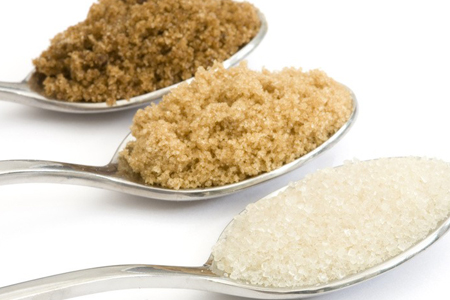You can have Diabetes and still have a sweet tooth. The best sugar substitutes add sweetness to foods and beverages without affecting your blood sugar or your waistline, according to the American Dietetic Association. Your best alternatives to sugar are also stable in different food environments and have been approved as safe for human consumption by the United States Food and Drug Administration (FDA). 1
Acesulfame Potassium
Acesulfame potassium is about 200 times sweeter than table sugar. Heat does not affect this sweetener, making it stable for cooking and baking. Since 95 percent of acesulfame potassium is excreted from the body unchanged it does not affect blood sugar, potassium levels or caloric intake. 1 As reported by the International Food Information Council, acesulfame potassium is used in 90 countries around the world and has been approved by the FDA since 1988. The FDA has established an Acceptable Daily Intake for acesulfame potassium of 15 mg per kg of body weight per day. According to the IFIC, a 150-pound person has to drink about two gallons of acesulfame potassium-sweetened beverage daily to reach this limit. 2
Sucralose
Sucralose is 600 times sweeter than its sugary competitor, yet it meets the FDA’s requirements for a no-calorie sweetener. Since humans and oral bacteria do not metabolize sucralose it does not affect blood sugar, weight or dental health. In baking, sucralose replaces or is combined with sugar to reduce calorie and carbohydrate content. The FDA approved sucralose for widespread use in 1998, and has reviewed more than 100 human studies on this sugar alternative to determine its safety. The IFIC maintains that over a lifetime Americans consume less than 20 percent of the 5 mg/kg Acceptable Daily Intake for sucralose. 3
Stevia
In 2008 the FDA approved two purified components of the stevia plant for use as sugar substitutes in diet soda, energy drinks, candy and other foods and beverages. Rebaudioside A and stevioside are up to 300 times sweeter that sugar. According to the ADA, the World Health Organization’s Joint Expert Committee on Food Additives concluded that these ingredients are safe for human consumption and set the Acceptable Daily Intake at 4 mg/kg/day, expressed as steviol. 4 In a published report the committee estimated that Diabetic adults consume up to 1.5 mg steviol per kg daily. 5
Neotame
The most intense of the FDA-approved sweeteners, neotame is up to 13,000 times sweeter than sugar. It is marketed as the sweetener without a bitter aftertaste, and is heat-stable for cooking and baking. In 2003 the Joint Expert Committee on Food Additives confirmed the safety of neotame and set the Acceptable Daily Intake at 2 mg/kg body weight per day. According to the ADA humans consume between 0.04 and 0.10 mg/kg/day. 1
Polyols
Polyols or sugar alcohols are about half as sweet as sugar with half the calories. The FDA allows the term “sugar-free” on foods that contain polyols because they replace sugar, but they are not considered nonnutritive sweeteners. Since humans partially absorb polyols, these sweeteners have a minimal effect on blood sugar. They also provide food for the intestinal bacteria that help regulate digestion and immune function. Look for sorbitol, mannitol or xylitol in foods like candy, gum, jam and baked goods. Note the warning label: “Excess consumption may have a laxative effect.” According to the ADA you should limit your intake of these products to 20 calories per serving. 1
References:
1. Position of the American Dietetic Association: Use of Nutritive and Nonnutritive Sweeteners http://www.eatright.org/About/Content.aspx?id=8363
2. International Food Information Council Foundation: Acesulfame Potassium http://www.foodinsight.org/Content/6/Everything-You-Need-to-Know-About-Acesulfame-Potassium.pdf
3. International Food Information Council Foundation: Sucralose http://www.foodinsight.org/Content/3147/Web-friendly%20pdf_Sucralose%20cons%20piece_1-10.pdf
4. ADA Hot Topic: Stevia http://www.eatright.org/About/Content.aspx?id=6826
5. WHO Food Additives Series: Safety Evaluation of Certain Food Additives http://whqlibdoc.who.int/publications/2009/9789241660600_eng.pdf
















